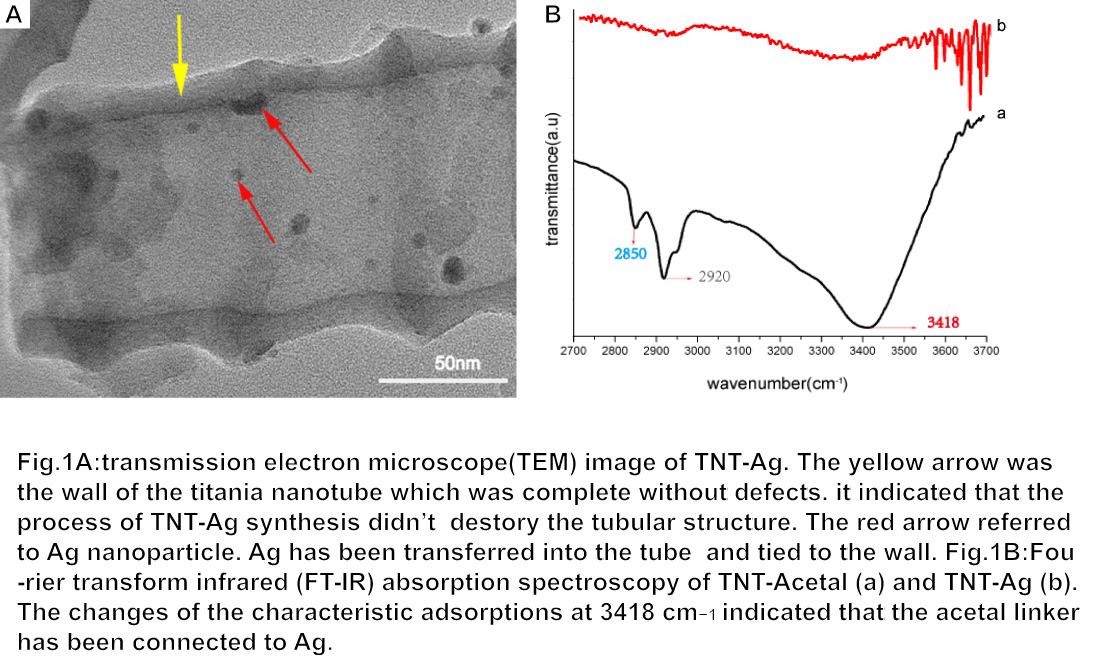Introduction: Titanium (Ti) implant is widely used in clinic for its good biocompatibility and mechanical properties [1]. But the post-implantation infection which often causes the failure of implantation brings pain to patients and causes the loss of economy as well. The traditional antibacterial drug administration methods such as oral medication or injection are difficult to achieve an effective drug dose in inflammation site, which may result in drug resistance [2],[3]. Therefore, the “on-call” drug delivery is needed for the treatment of post-implantation infection. In our study, the discrepancy of pH between the normal tissues and inflammatory tissues will be used to design a novel pH-sensitive drug delivery system. Ag nanoparticles will be released from titania nanotubes (TNT) array in inflammatory sites while trapped in nanotubes in normal sites.
Methods and Materials: TNT array was prepared by anodization. A acid-labile linker, acetal, was grafted to the wall of the titanium nanotubes. Then, Ag nanoparticles were tightly connected to the end of the linker. Ag loaded TNT array was evaluated by scanning electron microscopy(SEM) and transmission electron microscope(TEM). The presence of functional chemical linker was confirmed by Fourier transform infrared (FT-IR) absorption spectroscopy and X-ray photoelectron spectroscopy (XPS). The Ag release from TNT array at different pH value was evaluated by inductively coupled plasma-atomic emission spectroscopy (ICP-AES) [4]. The antibacterial activity of the system against gram-positive and gram-negative bacterial was tested. MC3T3-E1 osteoblasts were seeded on the Ag loaded TNT array to evaluate its biocompatiblity [5].
Results and Discussion: TNT array has homogeneous and uniform TNTs with an average diameter of 60 nm and length of 2.5 µm. The results of TEM confirmed the silver nanoparticles in the tubes. The changes of the characteristic adsorptions at 3418 cm−1 indicated that the acetal linker has been connected with Ag nanoparticles. Therefore, the results of SEM, XPS, TEM and FT-IR (Figure 1) indicated the ‘pH-sensitive Ag nanoparticles’ were connected with the wall of TNT. More Ag release in pH=5.5 condition than that in pH=7.4, which confirmed that the new system was pH-sensitive (Figure 2). The antibacterial efficacy of the released solution at pH=5.5 was obviously higher than that at pH=7.4, which indicated that the modification of TNT made it pH responsive antibacterial ability. There was no abvious discrepancy (p<0.05) between TNT array and TNT array with pH-sensitive Ag nanoparticles in the cell viability test and Alkaline Phosphatase (ALP) Activity Assay, which confirmed the cytocompatibility of this new system.


Conclusions: In our study, TNT array were successfully prepared on the surface of Ti substrate, and the pH-sensitive Ag was bond to the wall of TNTs. The novel Ag delivery system was pH-responsive to the micro-environment of peri-implant. The antibacterial assays indicated that the new system efficiently inhibited the bacterial adhesion while showed non-cytotoxicity to cells. The new system improved the drug efficacy, diminished the incidence of antibiotic resistance and showed a promising method in the therapy of implant related infection.
National Natural Science Foundation of China (Grant No. 81371182 and No. 81271186); The Natural Science Foundation of Zhejiang Province (No.LY13H140005 and No.Y2110400); Science Foundation of Zhejiang Provincial Department of health (No.2013KYA124)
References:
[1] Geetha M, Singh AK, Asokamani R et al. Ti based biomaterials, the ultimate choice for orthopaedic implants - A review. Progress In Materials Science 2009, 54:397-425.
[2] Zhang YC, Hou CH, Yu SM et al. IRAK-M in macrophages around septically and aseptically loosened hip implants. J Biomed Mater Res A 2012, 100A:261-8.
[3] Gristina AG, Oga M, Webb LX et al. Adherent bacterial colonization in the pathogenesis of osteomyelitis. Science (New York, NY) 1985, 228:990-3.
[4] Zhao LZ, Wang HR, Huo KF et al. Antibacterial nano-structured titania coating incorporated with silver nanoparticles. Biomaterials 2011, 32:5706-16.
[5] Wang GH, Liu SJ, Ueng SWN et al. The release of cefazolin and gentamicin from biodegradable PLA/PGA beads. Int J Pharm 2004, 273:203-12.